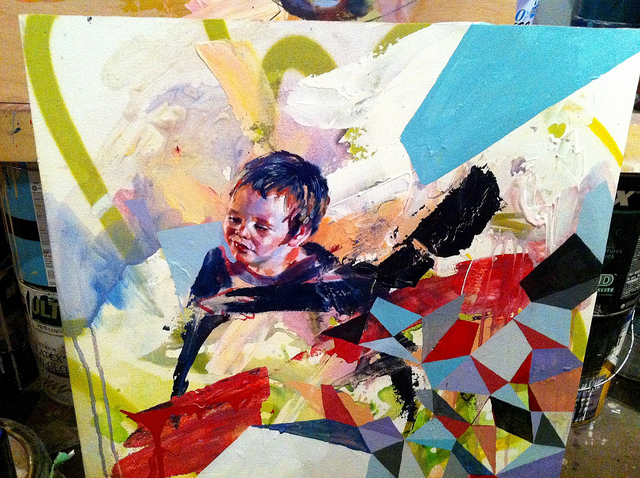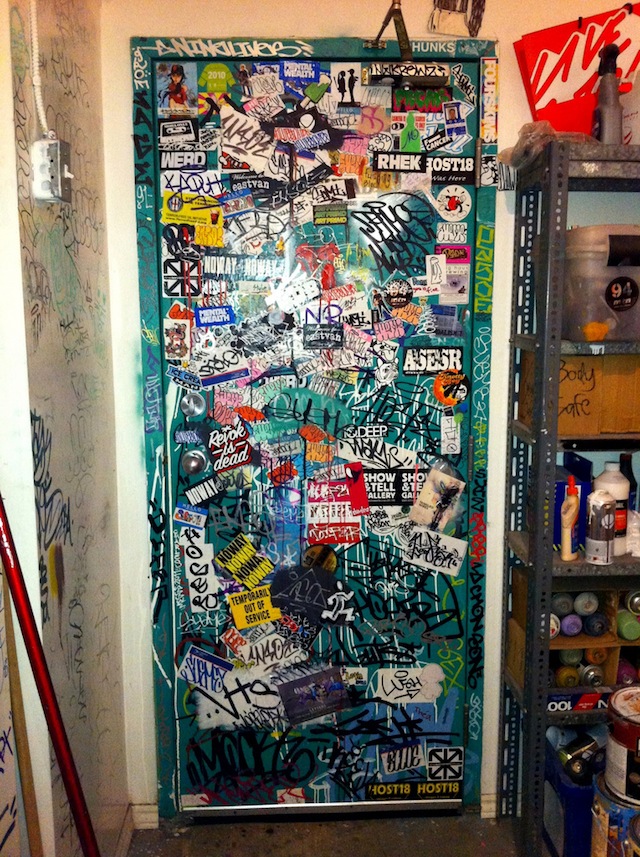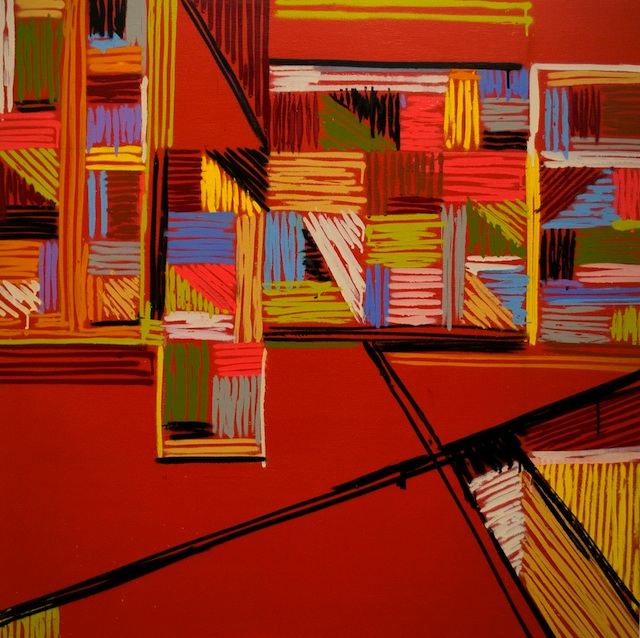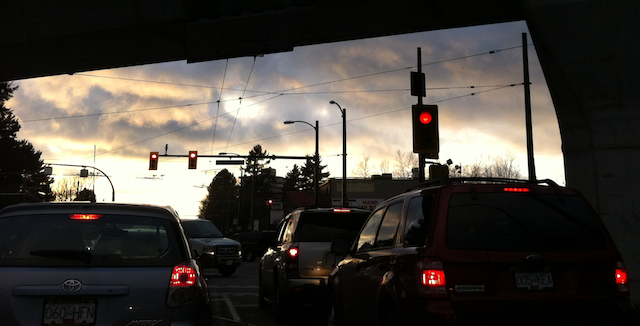
This is Part 2 of Ryan Gattis’ interview with Scott Sueme. Click here to read Part 1.
Ryan Gattis: What’s most inspiring to you right now?
Scott Sueme: Abstract painting and progressive graffiti piecing for the most part. I’m also really excited about working with other artists that aren’t necessarily coming from a graffiti background too. For instance, I worked with Andrew Young recently. He and I did some painting in Miami for part of Primary Flight.
RG: Andrew works primarily in oils, using multiple perspectives, and he did a portrait of you not too long ago. Is that right?
SS (laughing): Yes, he’s done my portrait. He works downstairs actually; we walked through his studio on the way up. He collages geometric shapes with wallpaper and other elements, then paints narrative driven realism in oils and blends the two together.

RG: So what was your experience in Miami?
SS: It was great. It was nice to be able to share the experience with some of my best friends from Vancouver. My close friend BIKES came up to shoot a short video, and having ENSOE and Andrew there too was great. The trip comes and goes very fast, and is an overload of inspiration and creativity. It’s hard to absorb it all within the week, really. Just being in the same neighborhood with all these amazing artists from around the world and painting at the same time was truly a privilege.
RG: What’s your dream project? If you could work on anything, whether it’s a building, or–
SS: The bigger the wall the better, I guess! You know what though, I think the OCP project was pretty close to a dream project. We were working with the architect who designed the building. Collaborating with Brad was awesome because I felt more involved in a complete process, a deeper side of creation, versus just the application of paint to a surface.
RG: As if you were adding that final touch to the construction?
SS: I think so. It seemed like a step beyond painting on the street or doing a mural. In those cases, you show up to the building and you paint it. But what was different there was that I got to work with the architect that designed it, feel where he was coming from, and then collectively worked the two-dimensional artwork into three-dimensional space. It really felt like an extension of the project, not something on top.
RG: And being able to dialogue with the person who actually designed it gave you a deeper level of insight into the entire project?
SS: Absolutely. It’s just a deeper process of creation. I’m dealing with the same mediums and surfaces I’ve been working with for years, but now I’m factoring in the shape of the building and its integration into the landscape. That’s the type of project that interests me these days. It’s not just a mural. It’s more than that. And in this case, the piece doesn’t exist on its own; it can blend into its environment and serve the greater purpose behind the structure in the first place.
RG: That builds into another question: what do you think the fundamental difference is between painting outside and doing something similar in a gallery space?
SS: I think they are both very different experiences. In a lot of ways, I feel the work writers do outside doesn’t often feel suitable for gallery spaces. It’s out of its natural context and doesn’t have the same effect. However, I feel like doing work indoors sets a precedent for being progressive and experimental. I’ve been finding that painting for indoor spaces brings out a unique side of my work that’s worth getting out and recording. Going out and doing pieces outside really helps me stay sharp and helps me see certain ideas out, whether they’re quick three-hour pieces or whether they take three weeks. I think they both inform each other, and at the end of the day it’s all great practice.
RG: Is it fair to say that your name is emblematic of that? There’s you, the painter: Scott. And then there’s the graff writer: SUEME. When you put them together, you fuse the abstract and the street into one moniker just like you’re trying to do with your art. I think it’s an interesting combination, one that speaks to exactly what you’re talking about.
SS: It’s definitely that idea, but it’s a new generation thing too. You can be whoever you want in the world today, so why not see what you can get away with? For me, that’s what SUEME meant for a long time–that it didn’t really make a difference what I was writing, but it was more about the act of painting–and, after a while, it started to embody that idea for me. That’s why I’ve kept the name and continued to use it. It’s part of me keeping that initial rebellious and active ingredient with me throughout any journey I choose to go on.
RG: You did an interview with Aerosol Fiends a while back, and talked about how you had at that point, you had over ten thousand shots of work–not just your work, but the work of other folks. How does that make your art better?
SS: I think seeing a lot of work definitely helps me identify with someone else’s work and understand what they’re doing. Now, there’s a very fine line with biting in graffiti–and I was just talking to ENSOE about this recently–that sometimes I’ll see a detail in someone’s graffiti piece and totally try to emulate it and figure out what makes it interesting to me. I’ll look at something and say, “I’ll like the way his ‘s’ kicks down and connects to a different letter,” or, “I like how they divided that negative space up.” I’ll see these things and I won’t carbon copy it, but I will take a mental note in my head, and then when I’m painting and it’s appropriate, I might try to emulate what I saw and what I felt was good about it.
RG: Reinterpreting it?
SS: Yeah, but it’s not something that I’m conscious of. I identify with the piece because I think something looks good in it; a detail appeals to my stylistic taste. I’ve never been someone that felt the need to express my originality as if there was something unique about who I am or the way I am–because I feel like formulas are more important than that. If you know what you like, and you know what looks good, there’s a formula to get there. So, in a way, when I play with that detail, I’m asking: “what is that formula, and how can I get closer to understanding why it spoke to me?” and in a way that helps you understand what you’re trying to go for, and to enjoy what you paint.
RG: It’s interesting to me that you use scientific language for that, because it works perfectly with the abstraction, a word like “formula,” for example.
SS: We are all products of our environments, and all this art we see is information we have to process, so here I am, always asking, “how can I digest it and filter it in and then pinpoint what works and push outward and create again?” That’s where I want to be. I want to be in the middle, that sort of hourglass shape. I want to see everything that I possibly can and then take what I like from it, and then put them all out again.
RG: It’s that level of open-mindedness, artistic open-mindedness, but also using yourself as a filter–as if to say, “here’s everything I’ve learned, and here’s how I’m dealing with it,” while creating at the same time?
SS: That’s it exactly. One example is that writers can only do a letterform so many times before it doesn’t look like the original letter anymore, you know? And the question then is: how can you find yourself in all of that? How you grow in all of that? The answer is you just have to do the work and see where it takes you.
RG: I relate to that, and it’s something I tell my own students: if you want to be a writer, you’ve got to be a reader. It has always been interesting to me that the graffiti term for a practitioner is also a writer, the exact same term for someone who makes a living with words. The parallel is already built in, so if you’re not cognizant and aware and passionate about what other people are doing, how good a writer are you ever going to be? In either discipline, you need inspiration and guidance. You need a foundation.
SS: Exactly. It’s the same idea, the very same.
RG: So, what do you have coming up? What’s next?
SS: More traveling, more pieces. Every time I finish a year, I say, “oh my god, how can the next one be more crazy?” I’m just going to keep on painting. I feel like that never gets old, chasing my relationship with paint and how I might use the material next. As long as I keep doing that, the projects will fall into place.

I thanked Scott for his time soon after and that was that. We descended from the loft and he showed me around as I took a few quick shots of the studio before walking out into the night. I stopped at the hard-bitten curb outside his building to get my bearings.
People were out, not many, but they were walking fast. Most were wrapped face-deep in coats, only looking forward, aiming themselves toward their nightly shelter.
And beside them, and around them, a middle-aged man hustled along. He was trying to sell a city map in a purple hard case to anyone that would listen. He only wanted two dollars for it. I shook my head in a no-thanks gesture when he picked me and waved it in my face, but this wasn’t enough apparently.
He pulled a Leatherman out of the folds in navy blue vest next, and snapped its knife out. It fell into place with a click.
“The blade’s still on it,” he said, twitching the thing at me, glinting lamplight down its length.
I took a look at that edge, and then a look at the man holding it. He wasn’t threatening me. Not really. He was just desperate to sell something, anything, as soon as possible.
“No thanks,” I replied, calm as the cold would let me. “I’m good.”
“Oh,” he said, twisting his mouth up like the tied-up end of a garbage bag before moving up the night-black sidewalk, tucking the Leatherman away and offering the same map to the next passerby (“Two dollars.”), and the next (“Two dollars. C’mon!”), growing more desperate with each refusal. I kept where I was, eying him as he went, up the street, and over a hill, disappearing into the dark.
A bus went by. Electrified wires dipping and humming in its wake. Only in Vancouver, I thought. The only city I’ve ever been in that had buses buzzing like streetcars.
And at that moment the shaking lines brought to mind one of Scott’s pieces–“Relish”, actually–and I thought of how the black lines in that piece looked just like bus wires.
It hit me then how his work wasn’t quite as abstract as some might think. After all, cities are just made up of angles, and lines, and edges.


Unless otherwise noted, photos by Ryan Gattis
